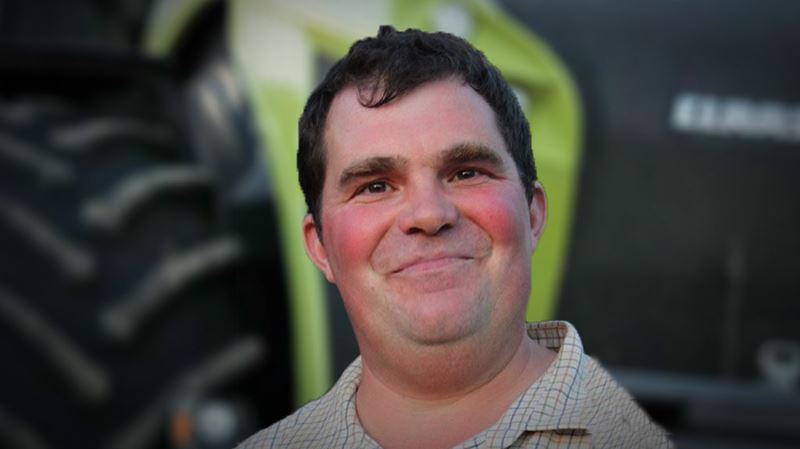Daniel Mayes, tractor operator - JJ & TH Haylock

That’s been the experience of Haverhill farmers JJ and TH Haylock and tractor operator Daniel Mayes. With around 1,200ha (3,000ac) of combinable crop ground to cover, including 720ha (1800ac) of their own plus contract land, timeliness of operations and working soils only when in good condition are critical elements of a system that blends both conventional crop establishment and minimum tillage.
To achieve those aims the business had been entrusting tillage and drilling tasks for wheat, barley, oilseed rape and beans to a conventional 370hp John Deere 8345R wheeled tractor, with the cost of tracked machines felt to be unnecessary and their unsuited to working the Suffolk clay without smearing. But with an expansion in contracted acreage, plus a desire to increase workrates to ensure cultivations and drilling can be carried out when soils are in optimum condition between short autumn weather windows, JJ and TH Haylock recently decided to reappraise the requirements for the top tractor in its fleet.
Drawn towards the tractive abilities and ease of road travel offered by an equal-wheeled tractor, they decided to look closer at this design. Rather than an articulated machine, though, the decision was ultimately made to choose a 530hp Claas Xerion 5000 as the new flagship for the farm’s fleet. Powered by a 12.8-litre Mercedes Benz six-cylinder engine driving through a continuously-variable transmission, the rigid-frame, four-wheel steer tractor offered a 7.5m turning radius from a 3.6m wheelbase, and a 17,450kg unladen weight. Added to this was the appeal of a mid-mounted cab that allows the rear wheels to be ballasted via a weight pack on the rear platform, while the fronts are weighted by a pack on the nose.
But knowing that turning this power and weight into traction would depend on the right choice of tyres, a lot of advice and thought was put into comparison and selection before Trelleborg High Power TM900s were specified when ordering the new tractor, which was delivered in June 2015. While the farm’s soils aren’t particularly stony, the heavy clays and some undulating land in places have proved a stern test of the Xerion 5000 and the 900/60 R42 tyres, says Daniel.
“The tractor works with some fairly demanding equipment. That includes not only the 13-leg, 6.6m Sumo Trio, but also a nine-leg Cousins V-Form subsoiler, a 10m Simba Cultipress and an 8f Gregoire Besson plough used with the tractor running on the land,” he explains.
“We also use the Xerion for operating either of the pair of drills we run according to soil and crop type, comprising an 8m Horsch Sprinter tine coulter drill and 6m Vaderstad Rapid disc coulter model with a Cultivating Solutions Rapid Lift toolbar up front.
“The services of Trelleborg’s Neil Sharman in setting up the tractor with the best combination of weights and pressures for the equipment it’s expected to work with were invaluable in getting the most from the machine in its first season.”
“For carrying out primary cultivations, getting sufficient traction to operate at the ideal forward speed is especially important with the Trio, as the discs need an element of speed to chop up and mix in trash, and the footprint of the tyres, with the number of cleats and the amount of rubber they put in contact with the soil, helps a lot here.
“To get full power to the ground we carry 1.8t of weight on the Xerion’s rear platform and 3.0t of front weights. That gives the best tractive performance from the TM900s when those on the rear axle are run at 1.3 bar (18.8psi) pressure, while those on the front are at 1.2 bar (17.4psi). And with those figures, as an example taken from one field I use 19 l/ha of fuel while achieving outputs of 4.5ha/ hr with the Trio using 59 litres/hr of fuel, with wheelslip averaging six per cent.”
With both primary and secondary cultivations and drilling to take care of, and spring as well as winter cropping, the Xerion is kept busy for much of the year, and so far is averaging around 900-1,000hrs annually. Daniel has been keeping wear records, and says that he was impressed with levels during the Xerion’s first full year on the farm.
“In total the tyre tread bars wore by 8mm during their first season, and although the land we are on isn’t especially stony, they stood up well to abrasion and cuts. We have to do a fair bit of travel between fields, and the tyres also perform well on the road, giving a very comfortable ride.”
The four-wheel steer tractor is much more stable at speed and offers greater steering precision on the road than an articulated tractor would, believes Daniel, while also being more nimble and accurate when making headland turns.
“It’s proven an excellent tractor for what we want, and I’ve been really impressed by the way it grips. That’s as much about the tyres we specified for it as the tractor itself, though,” he acknowledges.
“To get the best from a machine like this, we’ve learnt that it’s essential to have the best tyres, the correct pressures for the jobs the tractor is asked to do, and the correct ballast to make full use of the traction that the tractor and its tyres are capable of. I’ve been really pleased with the choice of both the Xerion and the TM900 High Power Trelleborg tyres.”